|
|
|
Sort Order |
|
|
|
Items / Page
|
|
|
|
|
|
|
| Srl | Item |
| 1 |
ID:
140023


|
|
|
|
|
| Summary/Abstract |
The forthcoming Asia Pacific Economic Cooperation (APEC) summit in the fourth quarter of 2015 in the Philippines might witness India gaining entry to the economic grouping. APEC is an international grouping of 21 countries including the United States and Japan, which promotes free trade among its members. With a new government in India, it was felt, that the Obama administration had an opportunity to revitalise its economic ties with India by the latter’s inclusion in the Asia-Pacific Economic Cooperation (APEC) forum. In January 2015 when President Obama visited Delhi, it was hinted that US would support India’s membership in APEC.3 The 13th meeting of RIC (Russia, India, and China) foreign ministers held in February 2015 also echoed similar views. External Affairs Minister Sushma Swaraj had added, “India’s participation in APEC has been welcomed by both China and Russia”.
|
|
|
|
|
|
|
|
|
|
|
|
|
|
|
|
| 2 |
ID:
140020


|
|
|
|
|
| Summary/Abstract |
From being “estranged democracies” to sharing a “Declaration of Friendship”, India and the United States have indeed travelled a long distance. The regularity and importance accorded to the annual strategic dialogues (five till date) are testimony to the increasing engagement between the two countries. The evolving Indo-US strategic partnership has been described as a vital component in the foreign policies of both India and the United States and one that is poised to gain increasing importance as Washington seeks to reorient its foreign policy with its rebalancing strategy towards the Asia-Pacific. Numerous reports have concluded that the rise of a powerful and democratic India in the Asian region and on the global stage is in the interest of the United States and also that American influence globally and in Asia in particular is in the interest of India
|
|
|
|
|
|
|
|
|
|
|
|
|
|
|
|
| 3 |
ID:
140022
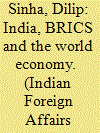

|
|
|
|
|
| Summary/Abstract |
BRICS is not an organised coalition seeking to create its own international order. It lacks adequate homogeneity and shared ideology for that. It is a pressure group of countries which want to be included in the decision-making forums of the international financial system. They feel that they have earned their place, and their credentials must be recognised. The slowdown in the growth rate in all BRICS countries, except India, has prompted many western experts to predict its demise. This appears to be an expression of desire rather than the result of objective analysis. The future shape of BRICS will depend on how the high priests of the present order react to their legitimate demands. What began as a prescient tip of a farsighted investment banker may either result in the reorganization of the existing system or lead to the setting up of a rival structure. The world would be better off in both eventualities
|
|
|
|
|
|
|
|
|
|
|
|
|
|
|
|
| 4 |
ID:
140017
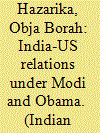

|
|
|
|
|
| Summary/Abstract |
Notwithstanding these contentions, cooperative relations between India and the US have become the mainstay of their relations in the post-Cold War era and the Modi government seems keen to further bolster the ties. India hopes to get US support to emerge as an economically, technologically and militarily vibrant country and the US views India as a valued partner, which can further the American vision of a stable Asia. Steps taken by Modi and Obama, however incremental, are symptomatic of the leaders’ understanding that India and the US have stakes in shaping the Indo-Pacific region in particular and the world in general in terms favourable to them, which will be best achieved through cooperation between the two nations.
|
|
|
|
|
|
|
|
|
|
|
|
|
|
|
|
| 5 |
ID:
140016
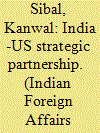

|
|
|
|
|
| Summary/Abstract |
The India-US strategic partnership is unequal. The US is a global power and India is, at best, a regional one. The USA would want to fit India into the jigsaw puzzle of its global interests, whereas India can only hope that the USA would increasingly align itself with its regional interests. Even achieving this would be difficult as the USA has historically pursued policies in our neighbourhood that have been detrimental to our interests; even now it is unable to overcome the legacy of the past, or go beyond the traditional ties it has developed with particular countries in our region, and the geopolitical need to maintain a certain regional balance so that its primacy is maintained. Nevertheless, the transformation in ties is real. If a realistic, and not an idealised, view of the relationship is taken, the overall assessment of the strategic partnership and its future seems to be positive in all objectivity.
|
|
|
|
|
|
|
|
|
|
|
|
|
|
|
|
| 6 |
ID:
140018


|
|
|
|
|
| Summary/Abstract |
[W]hile India-US strategic relations have rarely been more promising, India under the present government is showing an autonomous stance and is following it up with good relations with all countries that matter to India’s interests, whether in the neighbourhood, in the region or anywhere in the world. New Delhi’s interests on specific issues or regional problems often differ from that of the US, and so far as the country is concerned, the attitude is “India first”. However, it is in the mutual interest of both India and the US to develop strategic ties; both countries realise this and are working to build on a rich foundation. For doomsayers it may be sufficient to say that a lot of initiatives have been taken within a short time, and more time is needed for these to bear fruit. The point is that an environment is in place where the two countries can agree to disagree on certain issues (since no two national interests will ever be the same) without disengaging or allowing relations to stagnate
|
|
|
|
|
|
|
|
|
|
|
|
|
|
|
|
| 7 |
ID:
140019
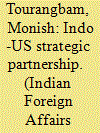

|
|
|
|
|
| Summary/Abstract |
So, at the end, the question really is not ‘who’s afraid of an alliance’, but ‘who needs an alliance’. Given the current geopolitical and geoeconomic dimensions involving India and the USA, Cold War type strict alliances – with clear demarcations about who’s on who’s side, and based on the idea of the existence of an ‘absolute other’ on all vectors of the relationship – may not be how it plays out. Alliances presume a threat perception and, given the nature of India-China, Sino-US, and India-US relations, and the complex interdependence that entwines them, building alliances and counter-alliances may not be the best answer to both India’s and America’s strategic needs. The way to a sustainable and stronger strategic partnership can only be built through a comprehensive and inclusive convergence aimed at progress, and through a single track strategic rationale of a threat from China’s rise. Hence, both sides need not be receptive and protective of all that each side says and does. Having said that, an initiative should not also be discarded just because it is American in origin – especially if it passes the test of interest and operational convergence. Though a constant reminder of what each country has done for the other is not a recipe for a sustainable relationship, a businesslike attitude towards why the two countries need each other, and how both could complement each other in the short, medium and long term, could be a pragmatic perspective on how to go forward together.
|
|
|
|
|
|
|
|
|
|
|
|
|
|
|
|
| 8 |
ID:
140021
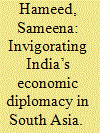

|
|
|
|
|
| Summary/Abstract |
For the past few years, India has made constant efforts to reach out to its neighbours by funding infrastructure projects to improve connectivity between India and its others neighbours in South Asia. It has already announced zero duty access for the least developed countries in the SAARC region, and has constantly pruned its sensitive list along with doses of economic aid. The present Government has made unambiguously clear that the prime focus of India’s economic diplomacy will be India’s immediate neighbourhood. The Prime Minster invited leaders of Afghanistan, Bangladesh, Bhutan, Maldives, Nepal, Pakistan, and Sri Lanka to his swearing ceremony, made Bhutan and Nepal his first international travel destinations, and resolved a seven-decade long territorial dispute with Bangladesh in December 2014. At the SAARC summit in November 2014 in Nepal, India backed three pacts to enhance connectivity and energy cooperation in the region.
|
|
|
|
|
|
|
|
|
|
|
|
|
|
|
|
|
|
|
|
|